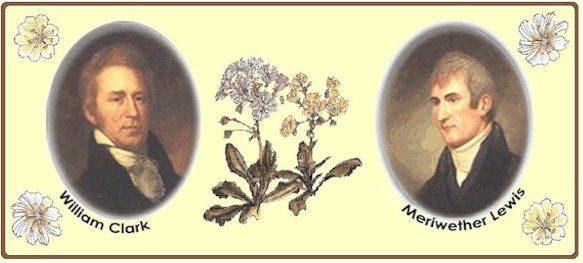WALLACE W HANSEN
Native Plants of the Northwest
Native Plant Nursery & Gardens
2158 Bower Ct S.E., Salem, Oregon 97301 E-Mail:
Wallace W Hansen
PHONE (503)581-2638 FAX(503)581-9957

WALLACE W HANSENNative Plants of the NorthwestNative Plant Nursery & Gardens2158 Bower Ct S.E., Salem, Oregon 97301 E-Mail:
Wallace W Hansen |
 |
| For information about Wallace W Hansen Northwest Native Plant Nursery & Gardens: Business Information (Ordering, etc.) | |
Updated January 23, 2003 |
Wallace Hansen Celebrates Lewis and Clark |
|
|
 
 |
|
The trip westward was long and hard but also eventful and exciting. Captains Lewis and Clark and the Corp met many folk of the tribes of Original People who inhabited the lands through which they passed. We skip ahead to what is now Oregon and join the party at the village they built and named Fort Clatsop. As was usual, they met the native tribes with what was by now their well-developed ritual. This consisted of formal greeting to the tribal leaders and explaining that the land was now owned by the United States, bestowing peace medals with President Jefferson's image on one side and two hands clasping on the other side and some other gifts, usually trade goods. The Corp members then gave sort of a parade, marching and shooting their guns. We can only imagine what the bemused native peoples thought about these activities. Captain Clark's Journal:
The Clatsop tribe enjoyed an idyllic life along the southern side of the Columbia River, living peacefully and well. The only Clatsop leader noted was Coboway, chief of one of the villages. He visited the expedition frequently and was welcome whenever he came by. He and his people aided the Corp in their winter preparations and told them where they might find elk and other game. Once the Clatsops told the Corp that a whale had washed ashore a bit to the south, a fine addition to their dwindling food supplies. Of this event:
During the winter of 1805-6, Captain Lewis wasted no time scouting around the area and collecting as many plant specimen as he could find. He spent many long hours describing each plant and where it grew, what he learned from the natives and sketching. Today we enjoy this legacy in the plants which are all around us. He wrote about what became our Oregon state flower, the Oregon Grape (Mahonia), on the trip home at Celilo Falls. At the Bridge of the Gods he saw our colorful vine maple (Acer circinatum). And at Fort Clatsop he noted Salal (Gaultheria shallon), Evergreen Huckleberry (Vaccinium ovatum), Blue Elderberry (Sambucus glauca), Sitka Spruce (Picea sitchensis), Mountain Hemlock (Tsuga mergensiana)--Oh so many of our Northwest Native trees, shrubs and perennials! What a bounty! And what a blessing he has left us to enjoy. |
|
|
|
|
|
Botanical Discoveries: Western Crabapple (Pyrus fusca) Fort Clatsop, Oregon, January 28, 1806 A small, moderately fast growing tree, the Western Crabapple (also known as Pacific or Oregon Crabapple) must have looked much like the bare branched image in our painting. Little did Captain Lewis realize he had found a delightful source of tiny (1/2") fruits that would come to be cherished by birds as well as man. |
|
|
The illustrated map below was created by renowned botanical artist Heidi D. Hansen especially for this website. Done in ink and watercolors, Heidi shows many of the plants Captain Lewis documented overlaid atop a map showing a portion of the journey. (Click on image for large view). |
|
|
|
Current events: December 7, 2002 - June 15, 2003 "Time Not Wasted -- Winter with the Corps" Exhibit Lewis and Clark National Trail Interpretive Center Great Falls, MT The exhibit portrays the winter encampments of the Lewis and Clark Expedition and how each encampment uniquely met more than the basic needs of survival – due to the natural surroundings and the objectives at the three different locations: Fort Dubois, Fort Mandan, and Fort Clatsop. The
Center’s winter hours are Tuesday through Saturday, 9 a.m. to 5 p.m.;
and Sunday, noon to 5 p.m.; the Center is closed Mondays during the
winter. For more information about the Center and its programs, call (406)
727-8733 or visit www.fs.fed.us/r1/lewisclark/lcic.htm
on the Internet. The Center is managed by the USDA Forest Service. |
|
|
|
|
|
|
|
Click here to return to my Home Page |
|
Questions about plants, click here: Regular Email to Wally To order, click here: Secure Email to Wally |
|
|
Comments or questions about our web site, click here: Webmaster |